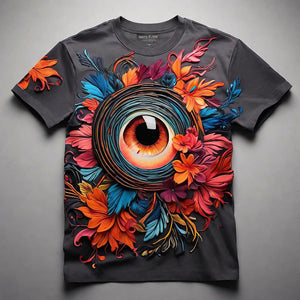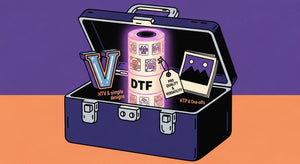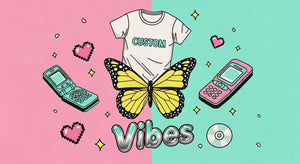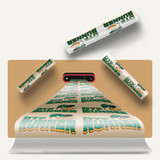Table of Contents
For custom apparel, the printing method really matters. Among these, the top two most commonly used methods are DTF transfer and HTV. Because of the amount of confusion that surrounds these two areas we are going to break down in this all-inclusive guide, DTF printing vs HTV — which is right for your custom apparel needs so that you can work it out easily. It will support you in deciding from knowing the different positives and some negatives these techniques have typically accomplished.
Understanding DTF Transfer
Advantages of DTF Transfer
DTF transfer is highly beneficial and there are many reasons people like it for custom apparel:
Color
DTF transfer will print a vivid image, always close to perfect, full-color output.
You can rest assured that these prints won't run out in a few years as they are weatherproof, and light safe so you need not worry of fading and cracking of prints.
Versatile
DTF transfer works great with different kinds of fabrics such as cotton, polyester and blends.
Less Weeding
With less of a need to weed compared to HTV, DTF saves both time and effort.
Disadvantages of DTF Transfer
It does, however, have a few disadvantages for DTF transfer:
Price
DTF transfer may cost more than HTV -especially for small runs.
Complexness
The process is can become a bit complex that needs some special equipment and material.
Understanding HTV
What is HTV?
In simple terms it just refers to designs that are cut out of vinyl sheets and pressed on to fabric using a heat press. HTV is frequently used on custom printed t-shirts, jerseys or apparel in general.
Advantages of HTV
HTV has a ton of pros that is why it is most popular for custom apparel :
Price
Price is the primary target when choosing from DTF transfer vs. HTV, with HTV appearing medium to low priced, particularly for small quantities.
Ease of use
HTV is deemed to be generally user-friendly and does not require purpose-made appliances.
Availability
HTV materials are available in many colors and finishes.
Disadvantages of HTV
But The HTV also has some limitations for:
The Weeding Process
HTV = weeding, which is slow and boring work.
Color Range
You may find less color range in the HTV compared to a DTF transfers.
Durability
HTV prints may not hold up as well through wash cycles compared to a DTF transfer.
DTF Transfer vs HTV Comparison
Print Quality
Print quality DTFTT-DTF TransferTop QualityImage Colorful and DetaileCleane SmoothENDIF(output a different end than usual) All some people will think about is what they see printed on HTV, and while it can be very good printing, it cannot achieve the same level of detail or color vibrancy as DTF transfer techniques.
Durability
On the other side, in case you want a much durable option, DTF transfers are the way to go. These prints can be washed many times over without any fading, cracking or peeling what so ever. N CanterburyIn contrast, HTV printing degrades with use and washing.
Versatility
DTF The wearable pattern is more changeable than use HTV. It is amazing for even more types of fabrics including cotton, polyester also mixed goods. HTV is most effective on cotton and other fabrics (not as good with really slick materials).
Cost and Efficiency
It's also much less expensive the HTV vs DTF transfer so for small runs and things that don't have a lot of intricate design on them. While the equipment cost is lower and the material costs may be relatively inexpensive, weeding can become a very costly burden in terms of time. DTF transfer has better quality and durability so is ideal for larger orders, more intricate designs.
Which one is the best way for my needs
Consider Your Budget
If you have a smaller budget and need to make your own custom T-shirts in lower volume, then HTV might be the best route. It is affordable and fairly simple to operate, perfect for beginners or hobby groups. You can choose your own according to your budget.
Assess the Complexity of Your Designs
DTF Transfer is the best option for detailed, multi-color designs with fine details. It can even handle complex images with razor sharp, vibrant colours so your designs don't appear amateur.
Think About Durability
Only for things that need to be washed and wear by the piece can DTF transfer part choose, durability first place. It is stronger, and your prints will be more durable and long lasting; they will not break or wear nearly as easy.

A More Advanced for Each
Enhancing DTF Transfer
Here are some more tips that you need to keep in mind while getting DTF transfer prints:
Good Preparation
Make sure your fabric is clean and pre-sprayed if necessary for better adhesiveness.
Correct Settings
Set your heat-press to the right temperature, pressure, and for an appropriate amount of time in order to get good results.
Layering
To achieve a more intricate image, layer multiple transfers.
Maximizing HTV
The following are some tips to get the best results using HTV:
Weeding Tools
opt for top quality weeding tools to facilitate the pruning process and you will avoid accidentally damaging adjacent veins.
Application Style
Protect Your Design Using Teflon Paper or parchment paper
Play with Texture
Try out unique HTVs elements and finishes like glitter or metal to mix up the design.
Troubleshooting Common Issues
DTF Transfer Issues
If you are facing any problem on DTF transfer print visit here:
Poor quality prints
When you notice that prints coming out yield poor quality, then it can be due to your heat press settings or that pressure is not distributed properly across the platen.
Deeper or Cracking
Check that you have the right temperature and the right pressure and that your fabric is DTF transfer (direct to film).
HTV Issues
If you are still having trouble with your HTV here are some common problems and how to fix them.
Weeding Problems
Make sure that your vinyl is cut all the way and use a lightbox to see where you need to weed better.
Adhesion Issues
Be certain your heat press is set to the correct temperature and pressure and that you have the appropriate vinyl for your fabric.
DTF Printing vs. HTV
The new way of customized apparel-making has its own set of pros and cons against the old traditional ways, hence the right kind for your business is determined by several factors. This great quality in prints, durability, and versatility makes DTF transfer an ideal solution for detailed designs and high volume orders.
HTV Conversely is very inexpensive and simple to use so its something that may be good for either your large quantities, or your not-so-desirable designs. You will want to learn what some of the strengths and weaknesses, in order for you to know which point your apparel can still be professional. It is very important that you invest in a proper printing method to get the best custom apparel. DTF transfer and HTV have its own demand mostly in the custom printing field.
Determine what you need, how much you are willing to spend and make a decision accordingly. This way, you would design dazzling custom apparel which makes your people surprised. There, our content can guide you in understanding which printing method will be the most suitable for your job. We wish you good luck!
Frequently Asked Questions (FAQs)
Any fabric on which DTF transfer can be used?
DTF transfer is very versatile and it works well on many fabric such as cotton, polyester and blends But Make Sure To Always Patch Test First In a Small Area, To Confirm The Product Works Well And Adheres Well.
Complexity: Is HTV good for detail?
However, while HTV can manage intricate patterns, it might not give the same level of detail and vividity as a DTF transfer. DTF transfer is a better choice for detailed, multi-color patterns.
What is the lifespan of DTF transfer and HTV prints?
DTF transfer prints are said to be highly durable and can maintain their color regardless of the number of times they were washed. Although HTV prints can be durable, it is often expected to break off with time or show signs of wear especially after being washed extensively.
Method For Beginners
It is also easier to use and less expensive compared to HTV which makes it more convenient for a beginner. It is the most basic form of printing that you can do yourself and does not need much in terms of specialized equipment, so a good beginner method to use if you are new to custom apparel printing.
Can I layered more than one HTV color in a single design
The short answer is: YES you can layer multiple HTV colors in a design! Be careful not to add too much thickness and apply each layer properly. For it to be done properly you will need a heat press that can control the temperature well.






